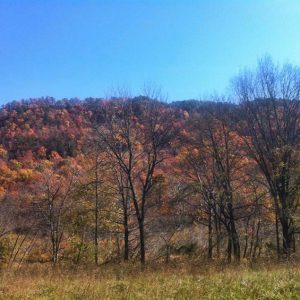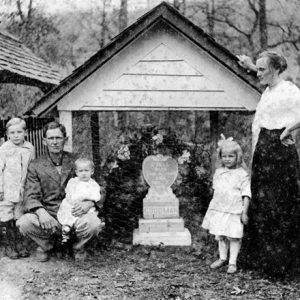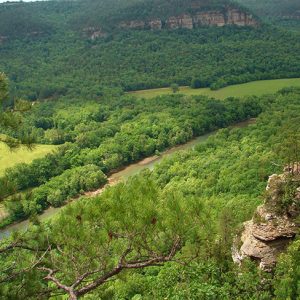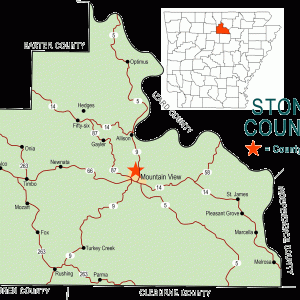calsfoundation@cals.org
Arlberg (Stone County)
Arlberg is a remote and sparsely populated community in Red River Township of Stone County on the west side of the middle fork of the Little Red River near the Van Buren County line. Arlberg is located two miles off Arkansas 110 in southwestern Stone County at the bottom of Angora Mountain. The Arlberg Arch, also known as Rainbow Rock, is a prominent natural monument in the area, located near the settlement on private property with limited access. In the twenty-first century, the area is mainly of historic interest and a place for hunting, fishing, and swimming.
In the region where Arlberg was later built, Civil War guerrilla and outlaw Bill Dark terrorized the hill people until early 1863, when the teenaged Jim Berry shot him in an encounter on the middle fork of the Little Red River near the future site of Arlberg. Even after the violence associated with the Civil War had subsided and Arlberg had been established, the area continued to have a reputation for lawlessness and roughness. A circuit judge remarked in the 1910s, “If a person wants to kill somebody, get him in Stone County.” Several murders took place in Arlberg, and brawls and gunfights were not uncommon. The popularity of moonshining in the region may have been a contributing factor.
Arlberg began as a railroad construction camp. The Arlberg post office was established in 1908, with George Henry Passmore appointed first postmaster on July 15 of that year, and the Missouri and North Arkansas Railroad (M&NA) trains began rolling between Neosho, Missouri, and Helena (Phillips County) on March 1, 1909. Before the post office was established, the community was usually listed as Red River or Lexington on the census reports. Old Lexington is located about one and one half miles to the southwest of the Arlberg post office site. The name Arlberg may have come from a railroad worker or promoter who compared the railroad being built to the famous Arlberg Railway in the Austrian Alps.
The mainstay of the community was the timber industry; with the railroad running through town, Arlberg became a regular stop for timber, other freight, and passengers. The timber resources were used to make oak barrels and kegs. The railroad had a depot at nearby Leslie (Searcy County) about twelve miles to the northwest. Up the tracks from Arlberg, the Ormond brothers opened a rock quarry that at one time sold rocks to the federal government. A short distance upriver from Arlberg, coal was discovered, and for a few years a coal mine was in operation there.
Three years after the coming of the railroad, a schoolhouse was constructed in 1912 for grades 1–8. The two-story building with a bell on top was built by Bart Edwards on land donated by J. E. and Clara Harness. By 1922, at least seventy students were enrolled. Teachers were required to have an eighth-grade education and to pass a teaching exam in Mountain View (Stone County). The building was also used as a Baptist church, a community building, and home of an Odd Fellows lodge.
Arlberg was at one time a bustling town with three general stores, the Mountain Home Hotel owned by Grant Betts and his wife, a blacksmith shop owned by “Uncle” Marion Bane, two barbershops, a post office, a grist mill, several sawmills, a merry-go-round pulled by horses, an orphanage, and a place to show silent movies (upstairs at the J. D. McGlathery general store). One of the earliest cafés in the county, owned by George F. Scarbury, was located in the town by 1915. A frontier doctor, Dr. Frank Clark, traveled on horseback in all kinds of weather to see patients.
James MacKrell, known as “Uncle Mac” to his young radio audience and as a radio evangelical to other listeners, is perhaps most remembered for his two campaigns for Arkansas governor in 1948 and in 1970. Shortly after moving to Arkansas from Texas in 1929, he founded an orphanage called Arkansas Academy, originally established in Arlberg and later moved to Mabelvale (Pulaski County) after a devastating flood heavily damaged the buildings in the late 1930s. The crumbling remains of the old rock canning kitchen for the orphanage are still visible in the undergrowth at Arlberg.
The lifeblood of the community, the M&NA railroad, was plagued with serious problems from the beginning. The topography of the Ozarks created natural difficulties, flooding was frequent along the line, there was sparse population with limited agricultural and industrial productivity, the railroad was poorly constructed, maintenance was inadequate, and there tended to be intermittent mismanagement, which included high wages the company could not afford. Devastating floods, especially those of 1927 and 1945, drove away most of the residents of Arlberg and did extensive damage to the railroad tracks. The M&NA’s final run through the community was in 1946.
With the discontinuing of the railroad, not much was left of the hamlet. The post office closed on December 31, 1955, by which time most of the inhabitants had left, and mail was sent to neighboring Botkinburg (Van Buren County).
At one time said to be the biggest town in Stone County, Arlberg gradually disappeared, reclaimed by the forest. A few former residents organized an annual homecoming beginning in 1985 and held every July 4 in Arlberg to visit, reminisce, and celebrate a town that once was.
For additional information:
Davis, Michael A. “The Legend of Bill Dark: Guerrilla Warfare, Oral History and the Unmaking of an Arkansas Bushwhacker.” Arkansas Historical Quarterly 58 (Winter 1999): 414–429.
Handley, Lawrence R. “Settlement Across Northern Arkansas as Influenced by the Missouri & North Arkansas Railroad.” Arkansas Historical Quarterly 33 (Winter 1974): 273–292.
“Hanging Out: Cafes and Gathering Places in 20th Century Stone County.” Heritage of Stone 41, no. 2 (2017): 1–2.
Landrum, Tonya. “Only Memories Remain: A History of Arlberg.” Heritage of Stone 18, no. 2 (1994): 37–50.
Moritz, Bob. “Memories of Arlberg—Once-Booming Railroad Town Has Faded Into History.” Arkansas Living, October 2017, pp. 16–17.
Sallee, Bob. “‘Uncle Mac’: Renaissance Man with Arkansas Roots.” Arkansas Democrat-Gazette, March 11, 1997, p. 4E.
Simmons, Grace Clark. “Town of Arlberg, Remembered by a Former Resident.” Heritage of Stone 18, no. 2 (1994): 36.
Kenneth Rorie
Van Buren, Arkansas

 Arlberg
Arlberg  Goodman Family
Goodman Family  Little Red River Valley
Little Red River Valley  Stone County Map
Stone County Map 



In Austria, we have a famous skiing area, with resorts such as St. Anton, in the western part of the country that bears the same name.